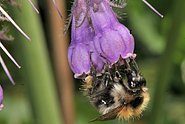Robust, quantitative understanding of the diverse ecological needs of species is needed to inform effective biodiversity conservation, now and in the future, but is lacking for most species. The advent of "big data" in ecology presents unprecedented opportunities to fill this gap and to disentangle the diverse drivers of biodiversity. Variable and model selection in sparse (small sample sizes for most species), high-dimensional (large pool of candidate predictors) problems is, however, non-trivial. Here, we employ cross-validated Bayesian projection predictive variable selection and shrinkage priors to identify, from a list of 70 ecological and biophysical candidate predictor variables, the minimal subset that best predicts the habitat preferences and distributions of 103 species of amphibians, birds, butterflies, dragonflies, and grasshoppers using the city of Zurich, Switzerland, as a case study. We contrast the predictive performance and ecological inference of models fit with the full set of predictors using shrinkage priors (exhaustive models) to models fit with a limited number of predictors obtained by compiling predictors from the full list of predictors using weakly informative priors (selective models). We show that exhaustive models excel in predictive performance, albeit at the cost of greater model complexity compared to selective models. Results from the selective models reveal the importance of access to aquatic habitat for a wide range of taxa, relative to other drivers such as urbanisation, vegetation and environmental hazards. These results are complemented by more nuanced insights from the exhaustive models into the importance of specific types of aquatic habitat (ponds, lakes, streams) and vegetation (herb, shrub, canopy cover) for the distribution of urban biodiversity, as well as the different spatial scales at which drivers are of predictive relevance. Our findings demonstrate the potential of shrinkage-based Bayesian variable selection to leverage big ecological data for species distribution modelling, and contribute to the development of concrete guidelines for urban planning and infrastructure design that account for biodiversity conservation.
Siehe DOISiehe Institutional Repository DORA












